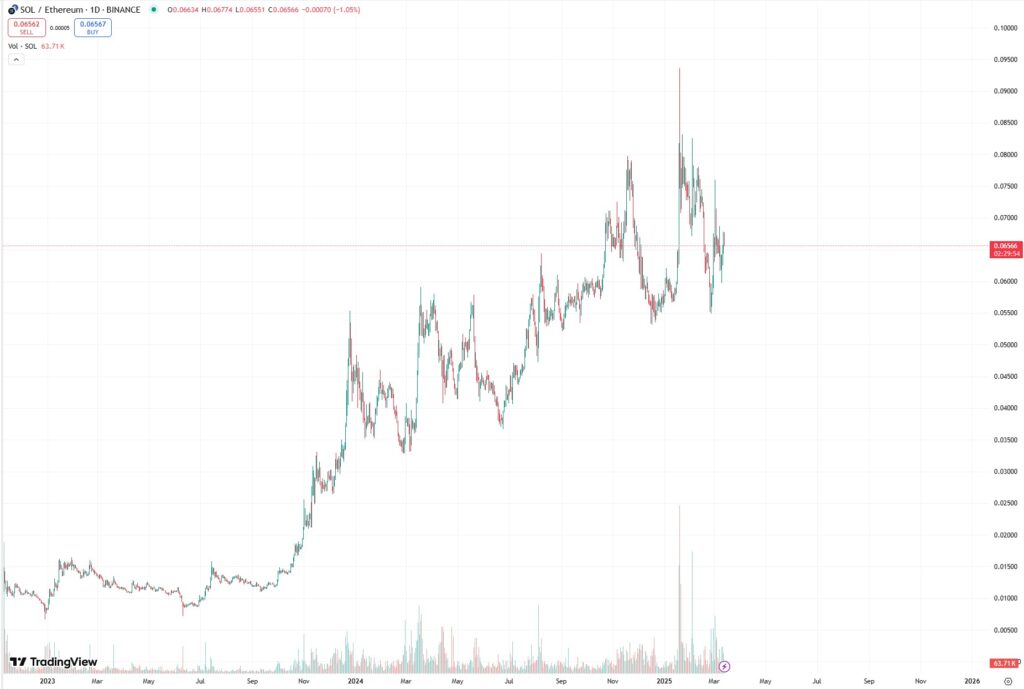In a notable development for the cryptocurrency landscape, the Chicago Mercantile Exchange (CME) is set to launch Solana (SOL) futures on March 17, marking a significant milestone for this emerging digital asset. This move comes as industry experts anticipate the first U.S. exchange-traded fund (ETF) listings for Solana, as reported by Chris Chung, the founder of Solana-based swap platform Titan. The rollout of these futures contracts represents a pivotal moment, following Coinbase’s earlier launch in February, as it positions Solana to gain greater legitimacy within the financial market.
“The listing paves the way for the eventual approval of SOL ETFs,” said Chung.
Futures contracts are agreements to buy or sell an asset at a future date, providing a standardized framework that assists in measuring an asset’s performance. As Chung notes, the introduction of regulated Solana futures signals a maturation of Solana as an asset, which could facilitate the approval of additional financial products by U.S. regulators. The industry’s appetite for futures contracts is bolstered by the existing market for Bitcoin (BTC) and Ether (ETH), which have seen successful ETF approvals, setting a precedent for Solana.
Beyond the realm of memecoins, which have significantly fueled Solana’s recent growth, Chung envisions that these new financial products will attract more substantial investment. This includes encouraging the development of real-world applications like payment systems and remittances. Despite the allure of trending memecoins, which currently account for a substantial portion of Solana’s revenue, the focus is shifting towards sustainable and practical use cases.
“These products will bring more serious, sticky capital and pave the way for the development of other real-world use cases,” Chung explained.
Interestingly, while February experienced a downturn in Solana activity due to recent scandals linked to memecoins, Solana still manages to hold its weight against Ethereum, rivaling trading volumes across its broader ecosystem. With the intrinsic challenges facing Ethereum, including a recent upgrade that significantly reduced transaction fees, Solana is quickly becoming a more appealing option for retail investors looking for alternatives in the cryptocurrency space.
As the cryptocurrency market watches closely, Bloomberg Intelligence has suggested a 70% likelihood that the U.S. Securities and Exchange Commission (SEC) will approve proposed spot Solana ETFs, signaling a promising future for Solana and its potential in navigating the competitive landscape of blockchain technology.
Impact of Solana Futures Launch on the Crypto Market
The upcoming launch of Solana (SOL) futures on the CME is significant for various stakeholders in the cryptocurrency landscape.
- Launch of SOL Futures:
- On March 17, the CME will introduce SOL futures contracts, marking a major step for Solana in the U.S. regulated market.
- This move follows the launch of Solana futures by Coinbase in February.
- Potential Approval for Solana ETFs:
- Analysts predict that the introduction of SOL futures will accelerate the approval of spot Solana ETFs by the SEC, expected as soon as May.
- ETFs could provide a more stable investment product for retail investors.
- Maturity of Solana as an Asset:
- Regulated futures suggest Solana is maturing, which may encourage regulatory agencies to approve more financial products based on this asset.
- Shift Beyond Memecoins:
- Futures and ETFs could shift the focus of Solana away from memecoins, which currently dominate its revenue streams.
- This could lead to serious investments in real-world applications like payments and remittances, fostering sustainability and growth.
- Competitive Positioning Against Ethereum:
- Favorable performance of Solana compared to Ethereum since early 2024 could attract retail investors.
- The ongoing struggles of Ethereum, particularly due to its transaction fee reduction, may position Solana as a more appealing option for those looking to invest in crypto.
“Solana is now the only option for retail investors wanting to get exposure to crypto beyond Bitcoin, but not willing to go full degen.” – Chris Chung
Solana Futures and ETF Prospects: A Game Changer or Just Another Trend?
The imminent launch of Solana futures on the Chicago Mercantile Exchange (CME) marks a significant milestone in the evolving landscape of digital assets. On one hand, it adds a layer of institutional credibility to Solana (SOL) and enhances its legitimacy as a serious investment option. Yet, in a saturated market characterized by constant innovation, it inevitably invites comparison with other cryptocurrencies and their associated financial products.
Advantages: The introduction of Solana futures is poised to attract institutional interest, signaling maturity in the Solana ecosystem. As Chris Chung, founder of Titan, notes, the futures contracts may lead to the approval of Solana ETFs, positioning Solana competitively against giants like Bitcoin (BTC) and Ethereum (ETH), which have already established their foothold with regulated ETFs. Notably, with asset managers like VanEck and Canary Capital at the helm of proposed spot Solana ETFs, the stage is set for new investment avenues that could draw in a broader audience, particularly retail investors looking for alternatives in a market currently dominated by Bitcoin and Ethereum.
Disadvantages: However, the reliance on futures contracts introduces a layer of complexity and risk. Futures can be notoriously volatile, and their pricing can be affected by numerous factors, including regulatory developments and market sentiment. Additionally, Solana has faced scepticism due to its earlier association with memecoins, which contributed to well over 80% of its revenue. While futures could expand the flexibility and applications of its blockchain, the transition from memecoins to more stable, long-term use cases is uncertain and could result in investor hesitance.
This development could significantly benefit institutional investors and financial firms looking to diversify their portfolios with regulated products, while potentially detracting retail traders who might still have concerns from previous scandals and volatility associated with Solana’s memecoin phase. The new futures market offers an enticing alternative for those wary of diving into the chaotic world of speculative investments. Moreover, the impending approval of ETFs could enhance Solana’s appeal as a ‘safe’ investment for users hesitant to fully commit to more volatile options like memecoins.
Comparatively, Ethereum has seen dwindling interest due to recent upgrades that have affected transaction costs and overall attractiveness. Solana’s strategic positioning as a potentially more appealing option for retail investors seeking exposure to cryptocurrency means it could exacerbate Ethereum’s challenges, potentially shifting investor focus and liquidity towards Solana as a viable alternative.
In summary, while Solana’s foray into regulated futures can enhance its market position, it also carries risks that require careful navigation. The success of these products could foster a new wave of institutional investment, yet they could also raise challenges, particularly for investors still wary of Solana’s past tumultuous reputation in the memecoin arena.

















